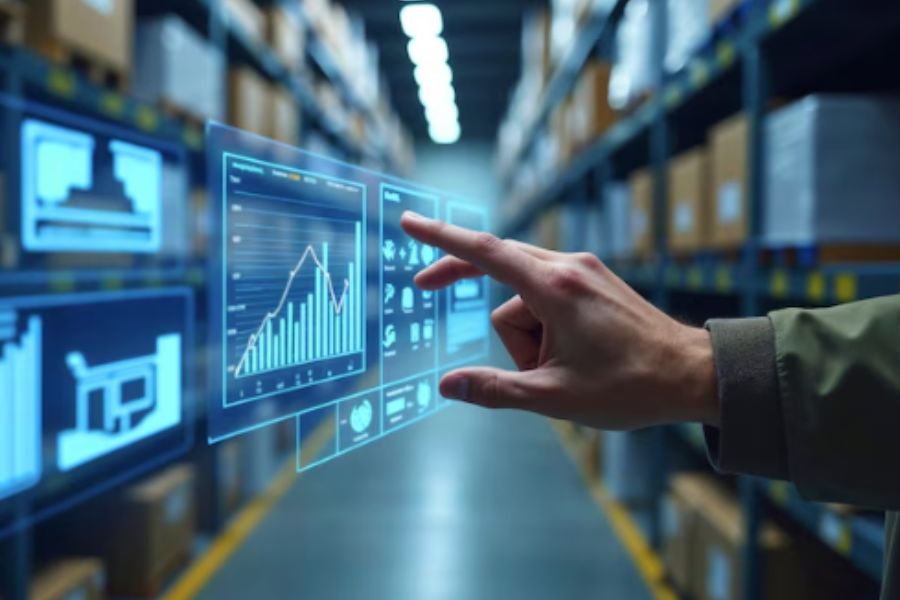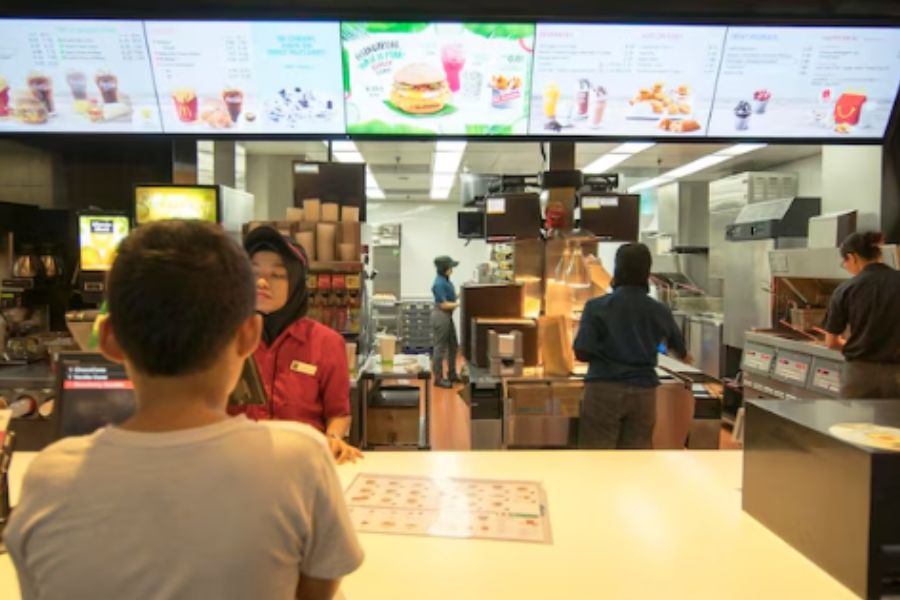To unlock the full potential of your fashion business, navigating the world of Point of Sale (POS) systems is essential. In this guide tailored for beginners, we delve into the intricacies of choosing, implementing, and maximizing an apparel store POS system, providing insights to boost efficiency, enhance customer experience, and ultimately drive profits.
How To Choose An Apparel Store POS System
With retail ecommerce revenues from apparel and accessories sales in the U.S. soaring to $180.5 billion in 2021, the industry is projected to reach $295.7 billion by 2025, according to Statista.

The significant growth is attributed to various factors, including the rise of digital channels, increased accessibility to online platforms via mobile devices, and ongoing technological innovations.
Given this landscape, selecting an effective apparel store POS system becomes crucial for entrepreneurs looking to capitalize on the expanding market and efficiently manage their fashion retail operations.
Determine Your Inventory Management Requirements
Managing inventory in clothing stores can be a complex task. To illustrate this, consider a hypothetical clothing store that exclusively sells a black and white t-shirt, available in both men’s and women’s sizes.
From just this single product, the store could potentially be handling 24 different SKUs or barcodes, accounting for variations in size (XS to XXL), color (black and white), and gender (men’s and women’s).
However, this example of a store with only one t-shirt is different from most clothing stores, which typically offer a more extensive range of products, often exceeding 10 or even 100 different shirts.
In such cases, the number of barcoded inventory items to monitor could easily escalate to hundreds or even thousands of SKUs. This emphasizes the significance of inventory management as a crucial feature of apparel store POS systems.
Even smaller stores frequently find themselves tasked with overseeing thousands of SKUs simultaneously, underscoring the necessity of an efficient inventory management system.
Determine Your Online Sales Channel
Beyond inventory management, the next crucial consideration when selecting a point-of-sale system for your clothing boutique is your online presence, whether you currently sell online or plan to do so shortly.
If you are already engaged in online sales, it is imperative to choose a POS system like ConnectPOS that seamlessly integrates with your existing ecommerce provider. This integration not only enhances the customer experience but also streamlines accounting, inventory, and customer management processes.
For those who do not currently sell online but envision doing so, opting for a POS system with a built-in ecommerce platform is a strategic move. An apparel store POS system that integrates effectively with your ecommerce platform offers customers the flexibility to make in-store or online purchases.
Furthermore, it provides real-time tracking of inventory availability, whether it’s online, in-store, both, or neither, allowing you to monitor stock levels across all purchase channels.
Determine Vendor Management Needs
Consider your current process for managing purchase orders. If you’re not manufacturing your products, you likely acquire items from wholesalers or directly from manufacturers and then resell them in your store.
This process can be time-consuming, involving tasks such as selecting items you believe your customers will like, creating purchase orders, waiting for new items to arrive, putting them up for sale, and possibly discounting items that don’t sell to free up cash for new inventory.
If this resonates with your business, it might be beneficial to explore an apparel store POS system, that seamlessly integrates your vendor management and inventory management. Many clothing stores opt for POS software that directly ties into their vendor management systems.
By using a clothing store POS that integrates inventory with vendor management, you not only receive alerts for low inventory but can also automate calculations such as reorder points (indicating when to place an order to restock items before they run out). Furthermore, such systems can generate and place purchase orders directly with vendors, ensuring you never face stockouts.
Think About Customer Relationship Management
One of the essential features included in most retail POS systems today is built-in Customer Relationship Management (CRM), proving to be a powerful tool for clothing stores. The integration of CRM within the POS system like ConnectPOS enables businesses to effectively market to their customers, monitor product sales, and generate personalized product recommendations and promotions.
With a CRM system in your POS, you gain the ability to reach out to past customers effortlessly. For instance, you can send emails notifying them about the arrival of your new fall or spring lineup. Additionally, sending personalized text messages, such as offering a loyal customer a 20% discount on their birthday, becomes a seamless process.
The apparel store POS system with CRM functionality also allows for the implementation of incentives like gift cards or certificates, encouraging future sales at your store.
Moreover, for businesses with an online presence, the integration of email capture at the physical store can be leveraged to entice customers to shop online, and vice versa. This seamless connection between the physical and online retail spaces enhances the overall customer experience and engagement.
Determine Reporting Needs
Are you interested in identifying your top-selling items or determining which products yield the highest margins, and deserve prominent placement in your store? Perhaps you’d like to assess the performance of individual members within your sales team, understanding who excels and who might benefit from additional support.
In the past, advanced reporting features like these were exclusive to complex POS systems. However, nowadays, they are increasingly becoming standard in most POS systems. Failing to track these critical metrics could result in missed revenue opportunities and more.
Determine Any Extraneous Needs You May Have
While clothing stores generally face minimal issues with major apparel store POS system providers, potential challenges still exist. Specialized services like measurements and tailoring may necessitate a more tailored solution. Similarly, if your store offers rain checks, layaways, buy now, pay later, or financing options, relying on an off-the-shelf solution may not be sufficient.
Refer to the checklist below as a guide; be sure to inquire about specific features before making a system purchase:
- Rain Checks
- Layaways
- Buy Now, Pay Later
- Customer Financing
- Consignment
- Tailoring or Repairs
- Dry Cleaning
- Delivery
Think About Time and Cost Commitment
One of the most crucial factors to consider when selecting a POS system for a clothing store is the commitment of time and cost. Some apparel store POS systems are nearly ready to use straight out of the box, offering robust support channels for a quick setup.
It is paramount to avoid business downtime or the need for additional after-hours wages (overtime) when training employees on a new system.
While comprehensive setups may require time for optimal functionality, it is important to balance this against your willingness to invest both time and money to maximize the benefits of your new system.
How To Operate An Apparel Store POS System
Foundational Features
At the heart of a typical apparel store POS is a central server directly connected to one or multiple terminal systems.
These terminals are equipped with essential components such as a cash drawer, receipt printer, credit card swiper, barcode scanner, and an employee interface. The employee interface can vary, featuring numerical and price buttons, a full keyboard with a monitor, or a touch-screen display.
Item Scanning Process
When a customer brings their selected items to the register for checkout, begin by scanning the barcode on each clothing item. If the barcode is damaged or missing, resort to manual entry using the UPC (Universal Product Code) or SKU (Stock Keeping Unit) number. If these numbers are unavailable or ineffective, some POS systems allow searching for the item through a style name.
As a last resort, POS systems often provide the option to manually enter prices using a universal dummy SKU. In such cases, make a note for later manual subtraction from active inventory.
Coupon And Incentive Input
After scanning all clothing items, input any coupons presented by the customer. Barcode-affiliated coupons can be scanned like merchandise, while others require manual entry. During manual entry, most POS systems automatically calculate dollar-off amounts or percentages. To ensure accuracy, keep a calculator handy as a failsafe for discount calculations.
Transaction Totaling
Once all items and applicable discounts are entered, proceed to total the transaction. The apparel store POS typically features a “total” button that automatically sums up the prices of purchased clothing items, subtracts any presented discounts, and adds applicable taxes where required.
Transaction Completion
After totaling the transaction, guide the customer in selecting a payment method. Await their payment, whether in cash, check, gift card (if sold by the store), or credit card swipe.
Post the completion of the monetary exchange, the POS system updates the store’s inventory, activates the cash drawer for making changes (if needed), and prints a customer receipt. For credit card transactions, a store copy of the receipt is printed for the customer’s signature.
Returns And Exchanges
As POS systems maintain inventory records, returns or exchanges are typically processed at the register. Begin by scanning the item for return or exchange. The system may prompt you to select a reason, such as “damaged item” or “did not fit.”
For exchanges, scan the new item. After totaling the transaction, the POS system guides further steps, indicating the need for change or credit card processing. Finally, a receipt, often accompanied by a short form for the customer’s signature, is printed, concluding the transaction.
Why Do You Should Choose ConnectPOS For Apparel Store POS Solution
ConnectPOS stands out as the ideal POS solution for apparel stores due to its tailored features and comprehensive capabilities.
- Tailored For Apparel Stores: ConnectPOS is specifically designed to meet the diverse demands of clothing stores, providing an all-in-one POS solution that aligns seamlessly with the unique needs of the apparel industry.
- Omnichannel Management: Benefit from omnichannel management capabilities, allowing you to oversee inventory, transactions, and customer interactions in real-time, whether they occur online, in-store, or through other touchpoints.
- Robust Inventory Management: Enjoy robust inventory management features, including real-time monitoring, automated updates for sales and restocks, stock transfers, stocktakes, and alerts for overstock and out-of-stock items.
- Data-Driven Insights: Leverage ConnectPOS’s data-driven apparel store POS to collect and analyze customer preferences, purchase history, and behaviors. This empowers retailers to tailor offerings and optimize business strategies for maximum effectiveness.
- Exclusive Sales Boosting Features: Increase sales for your clothing stores with exclusive features such as multiple variants and bundles, enabling easy sorting by brand, color, size, or material. Retailers can also create bundles with unique SKUs and comprehensive management options.
- Personalization Approach: Enhance customer experiences through personalized interactions. ConnectPOS allows retailers to view purchase histories, wishlists, and carts, enabling them to suggest supplementary accessories, clothing, or footwear that complement existing outfits.
- Diverse Payment Methods: ConnectPOS supports multiple payment solutions, from traditional card payments to modern wallets like Apple Pay. Additionally, it accommodates store credits, reward points, BOPIS (Buy Online, Pick Up In-Store), split payments, and more for enhanced customer satisfaction.
- Customer-Centric Special Offers: Win customer hearts with special offers directly at the apparel store POS. ConnectPOS allows retailers to reward every purchase with tailored recommendations, matching designs, and promotions, encouraging customers to make fully furnished purchases.
- Innovative Self-Service Options: Improve in-store convenience with ConnectPOS’s self-service app, enabling customers to swiftly finalize purchases through barcode scans. This feature reduces queues, enhances the shopping experience, and eliminates the need for constant assistance.
- AI Facial Recognition: Ensure quick and secure identification with AI facial recognition. This feature facilitates automatic enrollment in loyalty programs, encouraging repeat business and fostering customer loyalty through a seamless and personalized experience.
Choose ConnectPOS for a holistic, industry-specific POS solution that not only meets the current needs of your apparel store but also scales with your business as it grows. Elevate your retail experience and unlock the full potential of your fashion venture with ConnectPOS.
FAQs About The Apparel Store POS For Beginners
Can A POS System Track Employee Performance In An Apparel Store?
Yes, many modern POS systems offer features that allow tracking of employee performance. This may include sales metrics, transaction history, and other relevant data to assess individual and overall team effectiveness.
What Kind Of Hardware Is Required For A POS System Of Apparel Stores?
A typical hardware setup for an apparel store POS includes a main server linked to one or several terminals. Terminals typically include a cash drawer, receipt printer, credit card swiper, barcode scanner, and an employee interface. The interface can vary, ranging from numerical and price buttons to full keyboards with monitors or touch-screen displays.
How Often Should POS Systems For Apparel Stores Be Updated?
Regular updates are essential to ensure your POS system remains efficient, secure, and equipped with the latest features. The frequency of updates can depend on the software provider, but it’s generally advisable to stay current with the latest releases.
Are There Any Regulatory Compliance Considerations For POS Systems Of Apparel Stores?
Yes, apparel store POS systems must comply with various regulations, including those related to payment card security (PCI DSS), consumer data protection, and tax regulations. It’s crucial to choose a POS system that prioritizes compliance and stays abreast of legal requirements.
How Does A POS System Assist In Managing Customer Information And Preferences?
POS systems often include Customer Relationship Management (CRM POS) features. These allow businesses to track customer preferences, purchase history, and contact information. This information can be utilized for targeted marketing, loyalty programs, and improving overall customer experience.
Conclusion
It’s clear that a well-chosen and effectively utilized apparel store POS system is more than just a transaction tool—it’s a key player in shaping the success of your fashion venture.
By understanding the nuances of tracking employee performance, complying with regulations, managing customer information, and scaling with growth, you pave the way for a seamless retail experience. For a deeper understanding, please reach out to us for more details.



